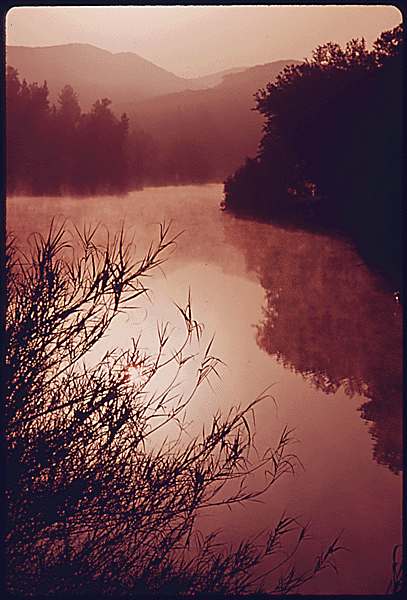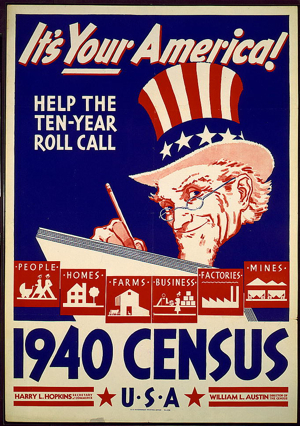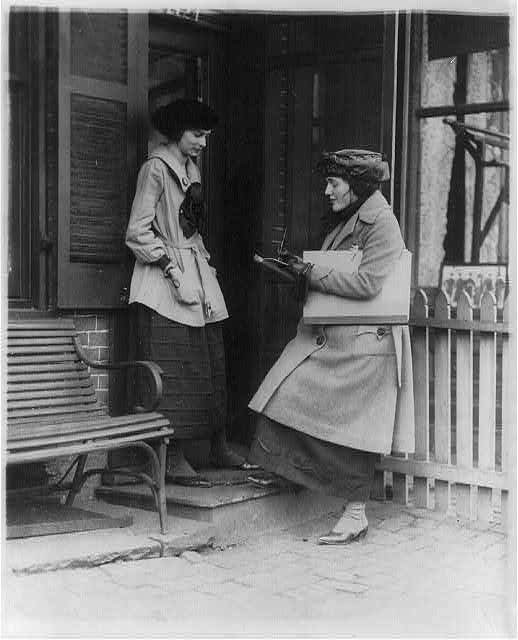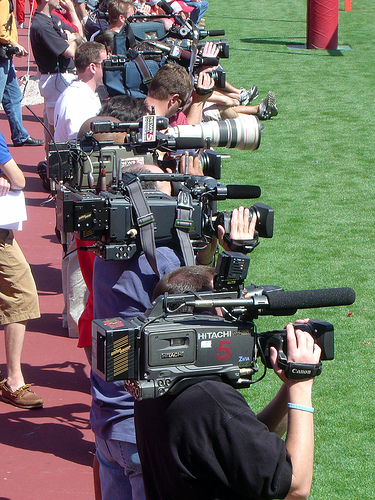 Public.resource.org is dedicated to using funds contributed by individuals to buy public domain content. This content is then released online in multiple locations such as the Internet Archive and Google Video for use by anyone. I love their tag line: Underwritten By The Feds! Overwritten By You!
Public.resource.org is dedicated to using funds contributed by individuals to buy public domain content. This content is then released online in multiple locations such as the Internet Archive and Google Video for use by anyone. I love their tag line: Underwritten By The Feds! Overwritten By You!
I spotted this in boingboing’s post Liberated public domain government docs surfacing online and I was immediately intrigued. This isn’t really an archiving issue exactly – though you could decide that it takes more of a LOCKSS approach to preservation. I also wonder how this approach could be used to finance the digitization of other public domain materials.
The website explains on their About Us page that they have recently applied for non-profit status with the IRS, so soon the purchase price of these materials could become a tax deduction for those who file US Tax Returns. They feature materials from 54 different US Federal agencies – from the Fish and Wildlife Service to the IRS. There are materials on the Environment, Public Health, Flying and many more.
But that isn’t all they are tackling – back in May they issued a message to The Internet discussing their attitude toward (and frustration with) the Smithsonian Images website. It begins:
We write to you today on the subject of SmithsonianImages.SI.Edu, a government ecommerce site built on a repository of 6,288 images of national significance. The site is breathtaking in scope, with imagery ranging from the historic cyanotypes of Edward Muybridge to historic photos from aviation, natural history, and many other fields. If the Smithsonian Institution is our attic, these photos are our collective scrapbook.
However, the web site imposes draconian limits on the use of this imagery. The site includes a copyright notice that to the layman would certainly discourage any use of the imagery. While personal, non-commercial use is purportedly allowed, it requires a half-dozen clicks before the user is allowed to download a low-resolution, watermarked image. An image without the watermark and at sufficient resolution to be useful requires a hefty fee, manual approval by the Smithsonian staff, and the resulting invoice specifically prohibits any further use without permission.
The letter goes into great detail about why they disagree with how things are being done – take a look if you are curious. Also -they didn’t just create this letter – they also created a free to download book titled Public Domain Prospectus which they declare as a tool for those researching the public domain status of the 6,288 images included (in their low resolution watermarked versions).
I went hunting on the Smithsonian Images site to see for myself. I found a few things. While the prices for prints or digital files do seem expensive to my eyes – there is the following note included in the Product and Pricing Information:
Special Note on Pricing: Smithsonian Photographic Services, as an instrument of the Smithsonian Institution, is a non-profit entity. Fees associated with the delivery of images represent material fees only and go to support the broader mission to create, archive, and preserve images associated with the Institution and it’s holdings.
That page also includes some information about how the images may be used, but for the full story I headed over to the Copyright Policy. That is when I started to get confused. The copyright policy on that page talks about “Use of text, images and other content on this website…”. Does that mean these same rules apply to the images you purchase as well?
Let’s take a closer look at one of the pages about a specific image. Here is a nice one of Fireworks over National Monuments. I click on the tempting ‘Download Image’ button and now I see more about what the Public.Resource.Org folks are talking about. One more click and I finally find what appears to be the official Commercial Use of Smithsonian Images page which concludes with:
Commercial distribution, publication or exploitation of Smithsonian files is specifically prohibited. Anyone wishing to use any of these files or images for commercial use or publication must first request and receive prior permission by contacting [Smithsonian Institution Office of Imaging & Photographic Services]. Permission for such use is granted on a case-by-case basis. A usage fee may be involved depending on the type and nature of the proposed use.
There is a special policy for school, teacher and student use of the watermarked versions of the images for free (with the right citations of course).
If I understand the Public.Resource.Org’s issues, it isn’t predominately with the price of the high resolution digital versions or even the print versions of these photos (though they DO touch on it in their letter and I think I side with Smithsonian Images on that aspect – it does cost money and time to make all that available). Rather it is with the firmness that Smithsonian Images claims that you must request permission to use any of the images you purchase for anything beyond personal or educational use. I think I like what NARA has on their website concerning the publication of their still photos which begins with these two paragraphs:
Generally, photographic records copied and sold by the National Archives and Records Administration (NARA) may be published without special permission or additional fees. NARA does not grant exclusive or non-exclusive publication privileges. Copies of Federal records, as part of the public domain, are equally available to all.
A portion of the photographs among our holdings are or may be subject to copyright restrictions. The National Archives does not confirm the copyright status of photographs, but will provide any information filed with the photograph. It is important to note that all of the digital images that are available on our website are in the public domain.
I can see how it might seem safer (from a “don’t sue us” point of view) to force a search by hand for each and every image as users request to use them. At the same time I would like to think that the folks over at Smithsonian Images already know which images are in the public domain. Maybe I am oversimplifying this, but I want to believe that the details of copyright are part of the metadata that could be supplied along with the date, photographer’s name and description.
I prefer the National Archives’ approach of stating clearly that they do not confirm the copyright status of photographs. They put it in the hands of the entity who wants to use the materials – though that might be small comfort to the average citizen not well versed in copyright rules.
The Wikipedia page on Copyright status of work by the U.S. government includes sections about digital historical material as well as work produced by government contractors. Reading through this makes me realize how quickly the copyright status of images such as those provided by Smithsonian Images and NARA can get confusing.
I think what Public.Resource.Org is doing with their propagation of public domain materials to locations where the public can actually get at them easily is interesting. I want to check back in a year and see how much they have set loose – and what materials they are asking for help to liberate. As I mentioned above, I think there could be some interesting models of individuals donating money to finance the digitization and of public domain materials. Something like what Fundable does to take pledges toward a specific fund-raising goal – and then only turn those pledges into funds if the goal is reached.
As for their great frustration with Smithsonian Images? Well, I see Public.Resource.Org’s side. In this age of Flickr.com – people are growing used to watching for Creative Commons Licenses. With so much out there with liberal Creative Commons Licenses and in the Public Domain, why struggle with images that are copyright protected unless you really need to?
I would like to think that rights management is one of the first things that would get sorted out before a large image collection is put online – especially if the goal is to produce a revenue stream. That said – I would love to know the real story here. I can imagine that the rights on many of those images are not clear cut. But if the Smithsonian Image people know that some of them are in the public domain – then why would they go through all that extra trouble to force a rights search for every image? Why not distinguish the ones which require research from those that don’t? Couldn’t it only help support the work of the Smithsonian to have their images used by as many projects as possible? Anyone reading this have an answer for us from the inside?
About the image above: Given that I prefer images without watermarks (as provided by Smithsonian Images) and that I know that the images on NARA’s site are in the public domain I went hunting for something pretty – and found the image I feature above. To find it yourself do a search for [Sunrise on Malibu Lake] in the Archival Research Catalog (ARC). These are the details included with the image:
Sunrise on Malibu Lake in the Santa Monica mountains near Malibu, California, which is located on the northwestern edge of Los Angeles County. The mountains contain the last semi-wilderness in Los Angeles County. This area so far has escaped development pressure. Some 84 percent of the state’s residents live within 30 miles of the coast and this concentration has resulted in increasing land use pressure. Several commissions have been authorized by the legislature to restrict coastal development, 05/1975.
Item from Record Group 412: Records of the Environmental Protection Agency, 1944 – 2000. NARA NAIL Control Number: NWDNS-412-DA-15109. Photograph by Charles O’Rear.
 While smart folks over at NARA are thinking about the preservation strategy for digitized 2010 census forms, I got inspired to take a look at what we have preserved from past censuses. In specific, I wanted to look at posters, photos and videos that give us a glimpse into how we encouraged and documented the activity of participation in the past.
While smart folks over at NARA are thinking about the preservation strategy for digitized 2010 census forms, I got inspired to take a look at what we have preserved from past censuses. In specific, I wanted to look at posters, photos and videos that give us a glimpse into how we encouraged and documented the activity of participation in the past. I also found some lovely census images in the Library of Congress Prints and Photographs catalog including the image shown here and:
I also found some lovely census images in the Library of Congress Prints and Photographs catalog including the image shown here and:


 October 1st, 2008 marks the
October 1st, 2008 marks the 
